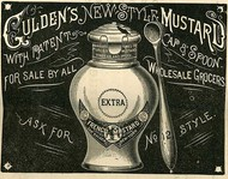Food Products Introduced in the 1860s
Posted By Brian Tomlin on March 12, 2012
Improvements in mechanical factory systems and the movement of many people from farms to cities helped drive the need for “convenience foods,” and many we still depend on were introduced during the 1860s.
- Tobasco sauce. Edmund McIlhenny (1815-1890), a New Orleans banker, was given a gift by a soldier returning to New Orleans from Mexico of some dried peppers that were acquired in Mexico during the United States-Mexican War (1846-1848. The soldier told him to try them in his food. He used one or two and like it, so he saved the seeds from the remaining peppers and planted them. He devised a spicy sauce using vinegar, Avery Island salt, and chopped capsicum peppers. McIlhenny packaged his aged sauce in 350 used cologne bottles and sent them as samples to likely wholesalers. He passed some of his sauce onto General Hazard, who was the federal administrator in the region. The general knew a good thing when he tasted it. His brother happened to be the largest wholesale grocer in the United States. General Hazard sent some of the hot sauce to his brother in New York, and told him it was made from a new kind of chili pepper. On the strength of the purchase orders that followed, Edmund McIlhenny began a commercial operation in 1868. More detailed history: http://www.tabasco.com/mcilhenny-company/about/
 Gulden’s Mustard. Started by Charles Gulden in 1862 in New York City, the original Gulden’s mustard was spicier than the current version. Today Gulden’s mustard is made in Milford, PA.
Gulden’s Mustard. Started by Charles Gulden in 1862 in New York City, the original Gulden’s mustard was spicier than the current version. Today Gulden’s mustard is made in Milford, PA.
- canned foods. Commercially sold canning methods had been developed in the early nineteenth century, but the products were not very popular because of the decreased quality of the foods having been canned. The Civil War contributed significantly to the popularization of canned foods in general due to the need to feed soldiers in the field and, in the South especially, the disruption of the fresh food supply. The army had to be fed and the government contracted with firms to supply food. Under difficult circumstances, people learned that canned foods such as condensed milk can be tasty and nourishing. The invention of practical can openers at the end of the nineteenth century made cans easier to open, making them even more convenient for consumers. Products such as canned peas and salmon were usually sold to people living on the American prairies, most of whom had never eaten the fresh product. In addition, losses due to spoilage caused by microorganisms remained high.
- peanuts as food. The first notable increase in USA peanut consumption came in 1860 with the outbreak of the Civil War. Soldiers on both sides turned to peanuts for food. They took their taste for peanuts home with them and peanuts were sold freshly roasted by street vendors and at baseball games and circuses. While peanut production rose during this time, peanuts were still harvested by hand, leaving stems and trash in the peanuts.
- jelly beans. Jelly beans as we know them today first surfaced in 1861 when Boston confectioner William Schrafft urged people to send his jelly beans to soldiers during the American Civil War.
- breakfast cereal. The first breakfast cereal, Granula was invented in the United States in 1863 by James Caleb Jackson, in Dansville, New York. The cereal never became popular since it was inconvenient, as the heavy bran nuggets needed soaking overnight before they were tender enough to eat. Granula was a precursor to the modern Grape Nuts cereal.
 ;
;


Comments